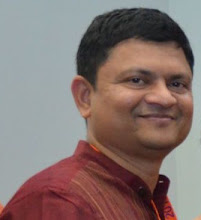... neti, neti ...
-Brihadaranyaka Upanishad, IV.V.15
Just as Yadnyawalkya is ready to renounce his home, one of his wives, Maitreyi asks him about the means of attaining immortality. Yadnyawalkya explains that anything we do, we do it indirectly for the Self. All the scriptures (vedas, itihasa, purana, vidya, upanishad, slokas, sutras, anuvyakhyanas, vyakhyanas) also spring forth from the Self. It is this Self that is indestructible. He goes on to describe the non-duality (अद्वैत ) and that it is that which one should strive for. Losing ones consciousness in it is what immortality is.
Maitreyi is still bewildered, so Yadnyawalkya further explains it thus: if there is duality then one sees another, smells another and so on. But when the duality is gone, what can one see (outside the Self) and with what? What can one smell, and with what? Through what can one know that due to which all is known? It is not this, not this (that) (neti, neti). Realizing such a Self is the only way to immortality.
Thus we see how the scriptures shifted from hero worship to polytheism to monotheism and there are already strains of monism with hints that gaining immortality means becoming one with this self.
Precursors of the current Hinduism have always been in flux, ever changing like a flowing river, trying to grasp at the meaning and purpose of life. To "what is Hinduism" too we can easily reply "neti, neti". May be that also holds for many current questions like "what is the solution to the crisis the politicians - that we ourselves elect - land us in" or "what is the solution to the perceived and real religious strifes going on all over the world". May be we need to take a deep breath, look inside ourselves and try to draw an all-encompassing picture like Yadnyawalkya had in mind, rather than quick short-sighted solutions.
Friday, December 29, 2006
Thursday, December 28, 2006
on multitheism
Sakalya: Yadnyawalkya, how many gods are there?
Yadnyawalkya: According to the "Hymn of all the gods" there are 3306.
S: Yes, but how many gods are there?
Y: 33.
S: Yes, but how many gods are there?
Y: 6.
S: Yes, but how many gods are there?
Y: 3.
S: Yes, but how many gods are there?
Y: 2.
S: Yes, but how many gods are there?
Y: One and a half.
S: Yes, but how many gods are there?
Y: One.
(S: Which are those 3306 gods?)
-Brihadaranyaka Upanishad, III.IX.1
In the dialogue after this Yadnyawalkya explains that there are only 33 gods and the rest are their manifestations. He goes on to say what the 33 gods are:
8 vasus viz. elements in which the universe is placed (वसावः ),
11 rudras viz. 10 human organs and the mind, the loss of which leads the relatives to weep (रुद ),
12 adityas i.e. the 12 months that carry the whole universe (especially the sun) with them (आदादनाः ),
Indra, and Prajapati (the lord of created beings).
Then he explains that the 6 gods are fire, earth, air, sky, sun, heaven which encompass all the above gods and so on. Later in III.IX.9 he states that there is One god, Brahman.
The vedas started with natural forces as their objects of reverence. At some point gods proliferated. But these were still "natural" gods having to do with elements of nature or our own body (later many of these were personified). The conversation above shows the inclination towards monotheism starting from an internal hierarchy. Of course, once an idea is born, it never completely dies. Polytheism too continued in some form with some subsets and underwent further mutations with time.
Yadnyawalkya: According to the "Hymn of all the gods" there are 3306.
S: Yes, but how many gods are there?
Y: 33.
S: Yes, but how many gods are there?
Y: 6.
S: Yes, but how many gods are there?
Y: 3.
S: Yes, but how many gods are there?
Y: 2.
S: Yes, but how many gods are there?
Y: One and a half.
S: Yes, but how many gods are there?
Y: One.
(S: Which are those 3306 gods?)
-Brihadaranyaka Upanishad, III.IX.1
In the dialogue after this Yadnyawalkya explains that there are only 33 gods and the rest are their manifestations. He goes on to say what the 33 gods are:
8 vasus viz. elements in which the universe is placed (वसावः ),
11 rudras viz. 10 human organs and the mind, the loss of which leads the relatives to weep (रुद ),
12 adityas i.e. the 12 months that carry the whole universe (especially the sun) with them (आदादनाः ),
Indra, and Prajapati (the lord of created beings).
Then he explains that the 6 gods are fire, earth, air, sky, sun, heaven which encompass all the above gods and so on. Later in III.IX.9 he states that there is One god, Brahman.
The vedas started with natural forces as their objects of reverence. At some point gods proliferated. But these were still "natural" gods having to do with elements of nature or our own body (later many of these were personified). The conversation above shows the inclination towards monotheism starting from an internal hierarchy. Of course, once an idea is born, it never completely dies. Polytheism too continued in some form with some subsets and underwent further mutations with time.
Labels:
brihadaranyak,
hindu,
monotheism,
philosophy,
polytheism,
upanishad,
veda,
yadnyawalkya
Subscribe to:
Posts (Atom)



